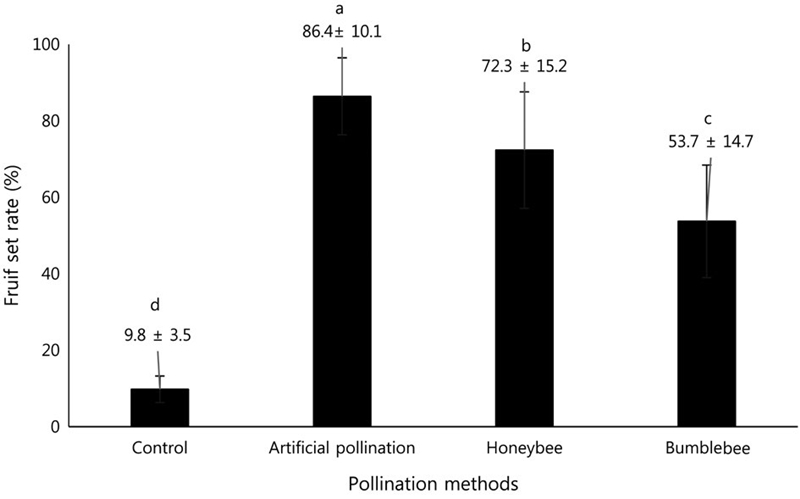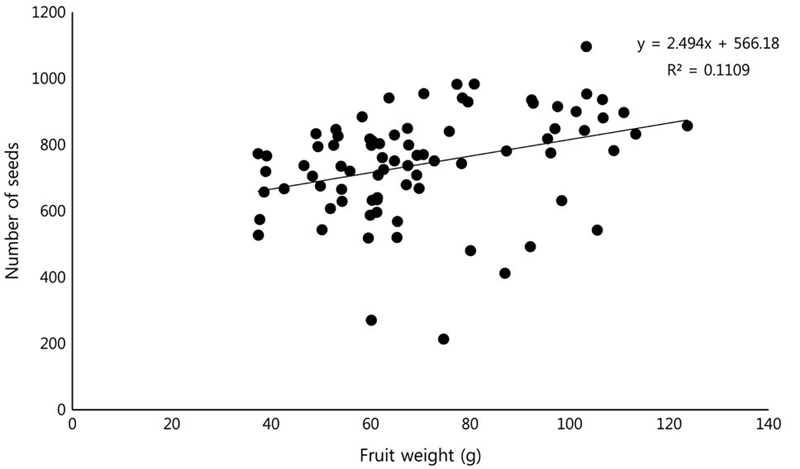
Comparison of the Foraging Activity and Pollination Effects of Honeybees (Apis mellifera L.) and Bumblebees (Bombus terrestris L.) in Gold Kiwi (Actinidia chinensis P. ‘Haegeum’)
Abstract
Because the number of flowers of gold kiwi (Actinidia chinensis P. ‘Haegeum’) that bloom is higher than that of conventional cultivars, artificial pollination is labor intensive. To verify potential insect pollinators of the gold kiwi, in this study, we compared the kiwi pollination behavior and effects of honeybees (Apis mellifera) and bumblebees (Bombus terrestris). The efficiency of pollinating activity of a bumblebee worker was greater than that of a honeybee worker. The traffic rate of bumblebees was 1.6-fold greater than that of honeybees. In particular, the percentage of bumblebees returning to the hive with pollen was 3.1-fold greater than that of honeybees. Because the time in the flower of bumblebees was 4 s shorter than that of honeybees, assuming that the foraging time was the same, bumblebees would visit 1.6-fold more number of flowers than honeybees. However, the pollination effects of honeybees were better than those of bumblebees. The fruit set rate of honeybee-pollinated flowers was 1.3-fold higher than of bumblebee-pollinated flowers. In addition, honeybee-pollinated flowers produced 1.2-fold more number of seeds; furthermore, the fruits produced by pollination with honeybee were slightly heavier and larger than those produced by pollination with bumblebee. These results can be attributed to the fact that the number of honeybee workers per hive is 20-fold more than that of bumblebee workers per hive. Owing to the larger number of bumblebee colonies required to achieve pollination effects than that of honeybee colonies, honeybees are considered better suited for kiwi pollination because of economic constraints. However, as bumblebees have higher pollination efficiency, determining effective density could promote their use as an alternative to honeybees in kiwi pollination.
Keywords:
Bumblebee, Honeybee, Kiwi, PollinationINTRODUCTION
Kiwi (Actinidia deliciosa) is a deciduous climbing vine or shrub belonging to the family Actinidiaceae, and it grows naturally in the subtropical region between 23° and 35°N around the Yangtze River in China (Fine, 1981; Lee et al., 1989). Kiwi vines are dioecious, and therefore, pollinators must transfer the pollen from male flower vines to female flower vines for fruit setting (Costa et al., 1993; Vaissiere et al., 1996; González et al., 1998). However, kiwi flowers are less preferred by pollinators such as birds and insects because they do not produce nectar to attract pollinators (Schmid, 1978; Clinch, 1990). Contrarily, both male and female kiwi flowers produce large amounts of pollen, which can attract hymenopterans that collect pollen (Pomeroy and Fisher, 2002). The preference of bees for the pollen of female flowers is lower than that for the pollen of other flowers blooming at that time because the pollen has no nutritional value (Jay and Jay, 1984; Goodwin et al., 2013a). Therefore, it is relatively difficult to pollinate kiwi vines with wild insect pollinators (Miñarro and Twizell, 2015). Consequently, several kiwi growers carry out hand pollination to obtain fruits of high quality (Goodwin and Perry, 1992; Razeto et al., 2005). However, kiwis bloom only for a short period, and therefore, hand pollination is labor intensive, especially in large kiwi-cultivating areas. Furthermore, separation of pollen from male vines before the flowering period is complicated and time consuming (Razeto et al., 2005; Lee, 2018). Thus, methods of pollination using insects as a substitute for artificial pollination have been extensively studied. In some studies, commercially managed insect pollinators, including honeybees and bumblebees, have been introduced into kiwi orchards and their pollination effects have been investigated (Clinch, 1990; Costa et al., 1993; Vaissiere et al., 1996; Pomeroy and fisher, 2002; Goodwin et al., 2013a). It has been reported that controlling the number of honeybee hives per unit area (Palmer-Jones et al., 1976; Craig and Stewart, 1987), increasing the number of worker bees per colony (Blanchet et al., 1991), and supplying sugar syrup to colonies improves the pollination effect (Goodwin, 1992). It has been verified that the pollen-collecting behavior of bumblebees is better than that of honeybees, whereas the pollination effects of bumblebees were the same as those of honeybees in kiwis (Pomeroy and Fisher, 2002). In addition, Goodwin and McBrydie (2013b) reported that the fruit set rate can be increased by installing pollen dispensers at the beehive entrance so that the forager bees can carry pollen. Winston and Slessor (1998) reported that spraying synthetic queen mandibular pheromone on kiwi vines increased fruit production. In Korea, there have been studies on kiwi pollination using insects, such as those comparing the pollination effects of honeybees and bumblebees on kiwi vines and confirming its availability (Kim et al., 2005). However, unlike that in other countries, in Korea, kiwi is grown in a relatively small area (less than 1 hectare per farm), and artificial pollination is carried out using pollen imported from other countries or collected from vines (Lim et al., 2014; RDA, 2017).
Recently, the cultivation of gold kiwi (Actinidia chinensis P.) varieties has increased worldwide as they have higher sugar content and are more palatable than green kiwis (USDA, 2016). In Korea, several kiwi varieties, mainly gold kiwi varieties, have been cultivated and disseminated since 2000, for the local cultivation of kiwi varieties (Kim et al., 2007; Kim et al., 2012). One of the new varieties of gold kiwi that is commonly grown in Korea is Haegeum because of its high sugar content and fruit productivity. However, the blooming time of Haegeum is earlier than that of other cultivars; thus, it is difficult to secure pollen from vine for artificial pollination (Jo et al., 2011). Therefore, kiwi farmers inevitably use cold-stored pollen, collected the previous year, for pollination (Cho et al., 2017). In addition, because the number of flowers that bloom is higher than that of conventional cultivars, artificial pollination is labor intensive. To overcome this limitation, in the present study, we investigated the use of insects for pollinating Haegeum cultivar. honeybees and bumblebees were selected as candidate insect species, and their pollination behavior during the flowering period, kiwi fruit set rate, and kiwi fruit properties were compared. Based on the comparison data, we recommend the most efficient pollinator insect among the two for Haegeum.
MATERIALS AND METHODS
Insects and crops
The experiments were conducted from May 5 to 24, 2018 in the Jeollanam-do Agricultural Research & Extension Services Fruit Research Center, Haenam-gun, Jeollanam-do, Korea (34°34ʹ53ʺN, 126°39ʹ53ʺE). We selected the golden kiwi fruit (Haegeum cultivar) for the study. It is an early-season kiwi fruit cultivar has been developed in Jeollanam-do Fruit Research Center, and its full-bloom day is on May 15. The vines were cultivated following the standard cultivation method (RDA, 2016). To compare pollination effects, a cross between three strains of European honeybees (Apis mellifera L., 3 frames, over 5,000 workers) selected by the Rural Development Administration and bumblebees (Bombus terrestris L., 200 workers) of the 16th generation reared under artificial conditions (26°C, relative humidity 80%; Yoon et al., 2010) were introduced into the study sites.
Treatment groups
The test plot consisted of four net house units (360 m2/unit, mesh: 2 mm×2 mm) with eight kiwi plants per net house. The interval between plants was 6.0 m×3.0 m, age of kiwi plants was six years, and average height of plants was 1.8 m. To collect pollens, the flowered branches (60 cm) of Haeson male cultivars (Cho et al., 2017) were placed in bottles containing distilled water, and the suspension was suspended on Haegeum vine, five branches per plant. To investigate the effect of different pollination methods, 2 colonies of 5,000 (2 frames) honeybee and 2 colonies of 200 bumblebees were installed at 1 m distance from the entrance of the four net houses on May 11, 2018. The bee colonies were removed from the greenhouses at 13 days (May 24) after installation. In each site, artificially pollinated and control units were placed. The pollen from Matua cultivar was collected on May 16, 2017 for artificial pollination, and then cryopreserved. On May 10, 2018, 20 g of the cryopreserved pollen was mixed with 4,000 mL of distilled water; to 200 mL of the suspension (Korean kiwi farming association, Suncheon, Korea), 0.8 g of food color was added (Red no. 2, Ojeong, Seoul, Korea). Artificial pollination was carried out in three randomly selected branches per female vine in each test plot, before bee colonies were installed. Immediately after artificial pollination, the flower clusters were covered with 1 mm×1 mm mesh until May 24, 2018 to prevent insect pollination. The control group consisted of 30 pistillate flower clusters, randomly selected just before the bloom, in each test plot. These remained sealed with paper cups until May 24, 2018. The pollination activity of honeybees, set rate of kiwi fruit, and physical properties of the harvested kiwi fruits were investigated to compare the pollination effects.
Pollinating activity and foraging characteristics
To compare the pollination activity of honeybees and bumblebees, we investigated bee traffic and number of bees visiting kiwi plants from May 14 to 16, 2018. Bee traffic was defined as the number of worker bees entering and exiting hives in 5 min; it was recorded at 1-h intervals from 08:00 to 19:00 h for three days. In addition, the number of bees pollinating the flowers per kiwi plant was observed at 1-h intervals from 08:00 to 19:00 h for three days; that is, the number of foraging bees visiting a kiwi plant at the same time intervals. We also compared the time the bees spent in the flowers (as the time spent collecting pollen or nectar from one flower by one worker) and the time taken to move from one flower to another. To compare the preference for male and female flowers between honeybees and bumblebees, the foraging worker bees were counted on female and male kiwi flowers for 5 min; it was recorded at 1-h intervals from 08:00 to 19:00 h for three days.
Effect of pollination method on the fruit set rate
The rate of fruit set was surveyed on May 24. It was measured in three plants of the honeybee-pollinated, bumblebee-pollinated, artificially pollinated, and non-pollinated groups. The rate of fruit set was calculated as the percentage of flowers that were pollinated in 30 randomly selected branches per plant in the insect-pollinated groups and 3 branches per plant in the artificially pollinated and control groups. Meanwhile, the rate of fruit set in flower clusters was calculated as the percentage of flower clusters in each plant that contained at least one pollinated flower.
Effect of pollination method on fruit quality
The fruits were harvested five months after pollination (October 16, 2018). Fruit quality was determined using 30 randomly selected fruits from each treatment group and fruit properties (weight, length, diameter, firmness, soluble solid content, SS-TA ratio, and seed number) were analyzed. The fruits were weighed using an electronic balance (CB-3000; AND, Seoul, Korea), and their length and diameter were measured using Vernier calipers (500-181; Mistutoyo, Kawasaki, Japan). Meanwhile, fruit firmness was evaluated using an 8-mm measuring rod of TMS-Pro (Food Technology, Sterling, VA, USA), and the vertical maximum pressure was measured along the fruit’s equatorial plane (5 mm sample move, 100 mm min-1). Next, juice was extracted by cutting the fruit at the point of median equatorial plane, and then squeezing the fruit and passing the pulp through cheesecloth. The content of soluble solids in the juice samples was measured using a digital sugar meter (PR-32α; Atago, Tokyo, Japan). Juice was extracted from five fruits of each treatment group, and 5 mL of each juice sample was diluted with 35 mL of distilled water and neutralized to pH 8.3 using 0.1 N NaOH; titratable acidity was determined using malic acid. The SS-TA ratio is the percentage of fruit soluble solid content/titratable acidity. The relationships between seed number and fruit weight, soluble solid content, titratable acidity, and SS-TA ratio were analyzed to determine the correlation between the number of fertilized seeds and quality of fruits.
Statistical analysis
The pollination behaviors of honeybees and bumblebees (bee traffic rate, bees visiting kiwi plants including female and male vines, foraging behavior, time spent on flowers, and time spent moving from one flower to another flower) were compared using a t-test. The preference of the insects for male and female kiwi vines was analyzed using the chi-square test. The effect of pollination method on fruit set rate and fruit quality was analyzed using a one-way ANOVA test. Data with significant differences identified using the Tukey’s HSD post-hoc test were subjected to post-hoc analysis. Pearson correlation, one-way ANOVA, and t-test were performed after verifying normality using Shapiro-Wilk test. After the correlation analysis, a liner regression equation was derived using a regression analysis if a significant correlation was confirmed. All statistical analyses were performed using SPSS PASW 22.0 package for Windows (IBM, Chicago, IL, USA).
RESULTS
Pollinating activity of the different insect pollinators
Overall, there was a significant difference in the bee traffic per day between the species (Table 1). The incoming (t-Test: t6=2.440, p=0.050), outgoing (t6=3.077, p=0.050), and total traffics (t6=2.940, p=0.026) of honeybees were 36-, 45-, and 38-fold greater than that of bumblebees, respectively. However, the colony size varied between bee species. However, when presented as a percentage, the incoming, outgoing, and total traffic rates of bumblebee were 1.7-, 1.4-, and 1.6-greater than those of honeybees, respectively, but there was no significant difference (Table 1). The number of honeybees that carried pollen and returned to the colony was 20-fold no significantly higher than that of bumblebees (t6=2.105, p=0.080). However, the percentage of bumblebee was 3.1-fold significantly higher than that of honeybee (t6= -3.090, p=0.021). The number of honeybees visiting a kiwi plant per day was 4.4-fold greater (22.6±6.5 bees) than that of bumblebees (5.2±2.1 bees) (Fig. 1). However, when presented as the percentage of plant visits per bee to the total bee traffic, the results showed that the number of bumblebees visiting a kiwi plant per day was 8.6-fold greater than that of honeybees. Both honeybees and bumblebees prefer male flowers over female flowers (Fig. 2). The number of honeybees visiting male flowers per hour (2.9±0.4 bees) was 4.5-fold higher than that visiting female flowers (0.2±0.1 bees) (t62= -5.281, p=0.0001) (Fig. 3A). Similarly, the number of bumblebees that visited the male flowers was 8-fold higher than that of bumblebees that visited the female flowers (t22=3.540, p=0.002) (Fig. 3B). Honeybees spent 10.1±0.1 s on a flower pollinating, which was 4 s longer than the time spent by bumblebees (Fig. 4A, t54=2.388, p=0.020); both honeybees and bumblebees spent 3 s moving from one flower to another (Fig. 4B, t34=0.083, p=0.935).
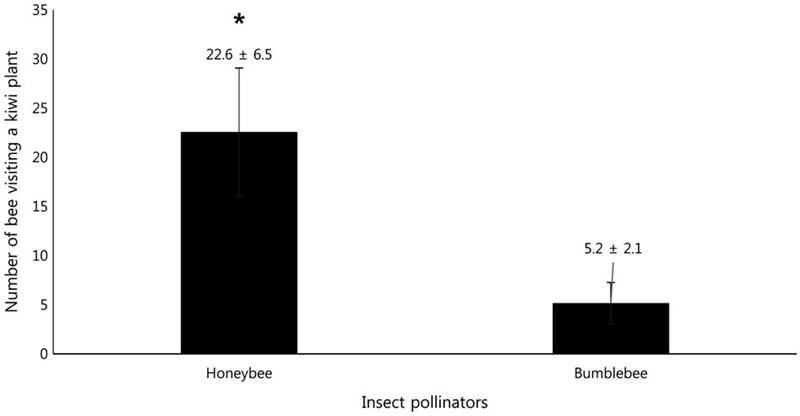
Comparison of the average number of honeybee and bumblebee bees visiting a kiwi plant per day. * indicates significant difference at p<0.05 among treatment plots.
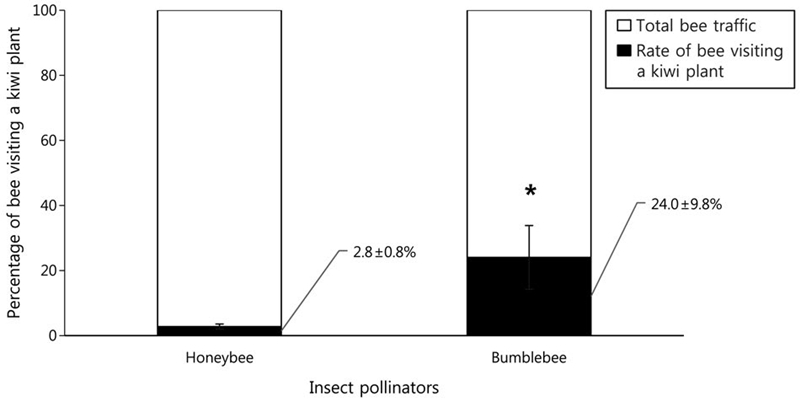
Comparison of the rate of honeybee and bumblebee bees visiting a kiwi plant per day. * indicates significant difference at p<0.05 between treatment plots.
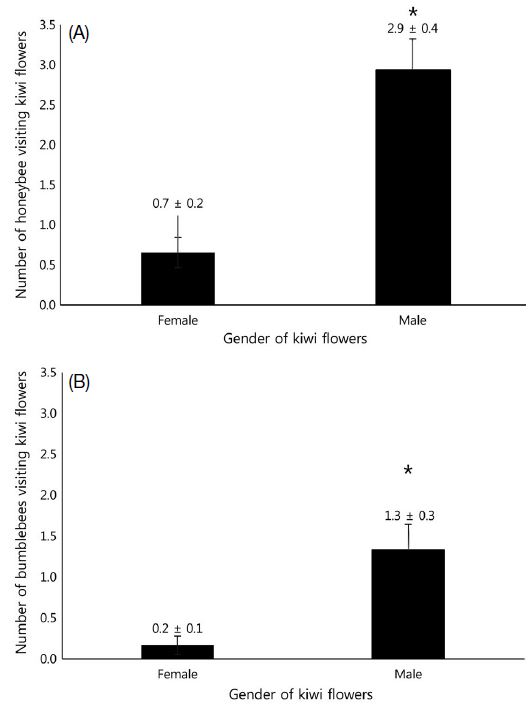
Comparison of number of (A) honeybee and (B) bumblebee visiting female and male kiwi flowers per day. * indicates significant difference at p<0.05 between treatment plots.
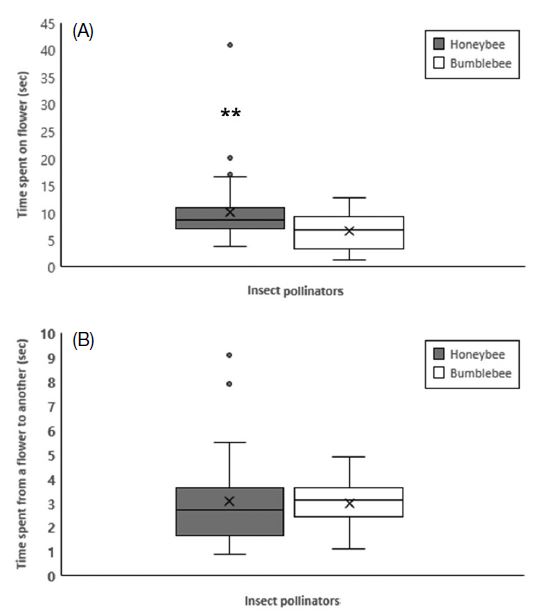
Comparison of (A) time spent on kiwi flower and (B) time to move from a flower to another flower between honeybee and Bumblebee. “×” and horizontal line in the box are mean and median values, respectively. “●” indicates more than 3/2 times of the upper quartile. ** indicates significant difference at p<0.05 between treatment plots.
Effect of pollination methods on the fruit set rate
There was a significant difference in the fruit set rate of kiwi plants among the different pollination methods (Fig. 5, one-way ANOVA test: F3,63=77.060, p=0.0001). Fruit setting by artificial pollination (86.4%±10.1%) was the highest, followed by honeybee- (72.3%±15.2%) and bumblebee-mediated pollination (53.7%±15.0%). The fruit set rate by artificial pollination was 1.2- and 1.6-fold greater than that of honeybee- and bumblebee-mediated pollination, respectively. The insect-mediated pollination methods showed 5.4~7.4-fold higher fruit set rate than that of the control, verifying the pollination efficiency of the insect. The fruit set rate by honeybeemediated pollination was 1.3-fold higher than that by bumblebee-mediated pollination. Although fruits were set in the control, they all dropped during fruit maturation.
Effect of pollination methods on fruit quality
There was a significant difference in the weight and size of kiwi fruits among the different pollination methods (Table 2). The weight, length, and diameter (weight: F3,77=25.897, p=0.0001; length: F3,77=14.728, p= 0.0001; diameter: F3,77=25.425, p=0.0001) of fruits obtained by artificial pollination were the highest, followed by those obtained by pollination with honeybees and bumblebees. In particular, the weight, length, and diameter of fruits obtained by artificial pollination were 1.5-, 1.1-, and 1.2-higher than those of fruits obtained by insect pollination, respectively. The fruits produced by pollination with honeybees were slightly heavier and larger than those produced by pollination with bumblebees, but there was no statistical difference. The firmness of fruit did not differ among the pollination methods (F3,77=1.138, p=0.236). The soluble solid content, and seed number were significantly different among the pollination methods (Table 2). The soluble solid content of fruits obtained by honeybee-mediated pollination was 15.6 Brix, which was 0.7 Brix higher than that of fruits obtained by bumblebee-mediated and artificial pollination (F3,77=3.589, p=0.030). The SS/TA ratio of fruits obtained by honeybee-mediated pollination was 32.4%, which was 1.3 and 1.4-fold higher than that of fruits obtained by bumblebee-mediated and artificial pollination, respectively (F3,77=4.780, p=0.011). However, the highest number of seeds was obtained by artificial pollination, which was 1.2- and 1.4-fold more than that obtained by pollination with honeybees and bumblebees, respectively (F3,77=19.137, p=0.0001). For titratable acidity, there was no significant difference among the pollination methods (F3,77=2.724, p=0.072). The weight of kiwi fruits showed a significantly lower positive correlation with seed number (R=0.333, p<0.01) and soluble solid content (R=0.233, p<0.05). On the contrary, there was no correlation between titratable acidity and SS-TA ratio (Table 3). A first-order regression equation was derived between the weight of kiwi fruits and the number of seeds (y=2.494x+566.18; ANOVA F1,78 =9.733, p =0.003, R2 =0.111, DW=1.303) (Fig. 6). On the other hand, it was not significant regression model between soluble solid content and fruit weight since the residual was too large and R2 value was too small (ANOVA F1,78=4.467, p=0.038, R2=0.054, DW=0.604).

Correlations between fruit weight and number of seeds, soluble solid content, titratable acidity, and SS-TA ratio
DISCUSSION
Pollinating activity
We compared the activity of honeybees and bumblebees during the blooming season of kiwi vines to select the most effective pollinator of Haegeum among the two. The percentage of bee traffic was not significantly different between the insect pollinators; however, the percentage of bumblebees returning to the colony with kiwi pollen was three-fold greater than that of honeybees. Furthermore, the percentage of total forager bumblebees participating in pollination was 1.6-fold higher than that of total forager honeybees. The percentage of forager bumblebees visiting kiwi plants was also fourfold higher than that of forager honeybees. Overall, bumblebees showed a more efficient pollination activity than that of honeybees in Haegeum. This can be attributed to one of the following reasons: bumblebee preference for kiwi flowers with no nectar but abundant pollen (Pomeroy and Fisher, 2002) and bumblebees are more adaptable than honeybees to confined spaces, such as a net house (Katayama, 1987; Dimou et al., 2008). Nevertheless, it is difficult to affirm that bumblebees are definitely more effective in kiwi pollination than honeybees. This is because of the following reasons. First, the number of worker honeybees is 20-fold higher than that of worker bumblebees per colony. In general, the pistil must be pollinated by large amounts of pollen for the kiwi to fruit (Hopping, 1990). For example, in Hayward cultivars, a full-sized fruit contains 1,300 seeds. As the pollen required for this is approximately 13,000, insect pollinators with pollen collected from male flowers have to visit female flowers several times (Hopping, 1990). In fact, Goodwin et al. (2013a) reported that worker bees must make five visits per flower for complete fruit setting in HORT16A, a gold kiwi cultivar. In this study, the total number of worker honeybees was more than 20-fold that of bumblebee workers, and therefore, the chances are more for honeybees to visit female kiwi flowers than bumblebees in confined spaces. Second, the preference of honeybees for kiwi female flowers is higher than that of bumblebees. Because kiwi is dioecious, the pollen of flowers on male vines must be transferred onto the stigma of the flower on female vines (Donovan and Read, 1990; Costa et al., 1993). Therefore, the preference of insect pollinators for female flowers is as important as that for male flowers (Goodwin and Steven, 1993). In this study, both bee species generally showed a higher preference for male flowers. B. terrestris presented a higher preference than honeybees for male flowers, whereas honeybees preferred female flowers (chi-square test x21=4.313, p=0.038). As kiwi flowers do not secrete nectar, the only means of attracting bees is pollen (Clinch, 1990). Our results reveal that the preference for kiwi flowers varies with bee species, because the preferences of bees might vary depending on the kind and composition of amino acids in the pollen (Leonhardt and Blüthgen, 2012). Particularly, female flowers of Hayward had limited number of visits by insects due to the low nutritional value of pollen, but honeybee visits were relatively more than those of other insects (Goodwin and Steven, 1993). On the contrary, it has been reported that the pollen from male flowers is favored by bumblebee than honeybee (Pomeroy and Fisher, 2002).
Pollination effect
In the present study, the results of fruit set rate and fruit quality suggested that honeybee was more effective than bumblebee. In general, the weight of kiwi fruits is positively correlated with the number of seeds (Hopping, 1990; Goodwin et al., 2013a). Our results also showed a low positive correlation between the weight of kiwi fruit and number of seeds, with a first-order regression equation. This indicates that the more the seeds produced through sufficient pollination, the better the quality of fruits produced (Aizen and Harder, 2007). Indirectly, this indicates that honeybee, which had more forager bees, pollinated more female flowers than bumblebee. Despite the number of forger bumblebees being 1/10 less than the number of forger honeybees, the fruit set rate and seed number were only 20~30% lower. Rather, it represents the fact that bumblebees have considerably better pollination efficiency per worker than honeybees. Pomeroy and Fisher (2002) reported that bumblebee visited more kiwi flowers than honeybees in the same time. In this study, honeybees stayed in the kiwi flower longer than bumblebees. Assuming that forager honeybees and bumblebees have the same foraging time (1 min), bumblebees visit 9~10 flowers and honeybees visit 6 flowers in 1 min; therefore, the number of flowers visited by bumblebees is 1.6-fold more than honeybees. In addition, Pomeroy and Fisher (2002) reported that bumblebees collect more pollen than honeybees and exhibits more crossing behavior between male and female flowers than honeybees; thus, bumblebee can exhibit greater pollinating efficiency than honeybees. Despite these advantages, as bumblebee is relatively less economical, honeybee, rather than bumblebee, is commonly used for kiwi pollination in New Zealand (Pomeroy and Fisher, 2002; Miñarro and Twizell, 2015). However, our results suggest that if the economic limitations associated with bumblebees can be overcome, they could be used as a substitute for honeybees in the pollination of kiwi flowers.
We compared the pollination effects of honeybees and bumblebees on kiwifruit in a confined space. The efficiency of pollination of a single worker bumblebee was excellent, but honeybees, owing to a high number of worker bees, showed greater effects in kiwi pollination. Therefore, considering the economic constraints, honeybees are more suitable for the pollination of kiwi than bumblebees. However, since our study was conducted in a limited space with no other pollen sources and only kiwi flowers, there is a limit to applying these results to open fields completely. During the kiwi flower season in Korea, because pollen source is more attractive to bees than kiwi flowers (Clinch, 1990), the behavior and effects of honeybees and bumblebees may change. In addition, honeybees and bumblebees differ in their activity in limited spaces (Katayama, 1987). Therefore, in further research, pollination behavior and effects of honeybee and bumblebee need to be investigated in open fields planted kiwi vines. Also, it is necessary to verify the economic feasibility by determining the effective density of bumblebees per unit area compared with that of honeybees in an open field.
In addition, artificial pollination showed higher effectiveness in terms of fruit set rate, fruit size, and weight than that of bee pollination. This could be because in hand pollination, the same flower is pollinated several times during the blooming period, which can result in the production of heavier fruits than those obtained by single pollination (RDA, 2017). The process to produce better kiwi fruit by hand pollination is labor intensive. In particular, the labor and time required to produce Haegeum plants with more flowers are higher than those for Hayward green kiwi. Based on our results, we believe that the use of insects for pollination of kiwi vines can be an alternative to artificial pollination. Because insect pollination produces smaller fruits than artificial pollination, future studies are needed to determine the most effective bee density to increase seed fertilization. In addition, various strategies should be evaluated to enable bees to pollinate more effectively, such as development of a pollen dispenser that can deposit pollen on foraging bees when they leave the beehive and techniques for grafting a male kiwi cultivar, preferred by bees, on to Haegeum cultivar.
Acknowledgments
This study was supported by a grant from the National Institute of Agricultural Sciences, Rural Development Administration, Republic of Korea (Project No.: PJ0133232019).
References
-
Aizen, M. A. and L. D. Harder. 2007. Expanding the limits of the pollen-limitation concept: effects of pollen quantity and quality. Ecology 88: 271-281.
[https://doi.org/10.1890/06-1017]

-
Blanchet, P., P. Douault and A. Pouvreau. 1991. Kiwifruit (Actinidia deliciosa Chev.) pollination: honeybee behaviour and its influence on the fruit. pp. 376-380. in Sixth International Symposium on Pollination, eds. by Heemert, C. and de Ruijter, A. Tilburg. Acta Hortic.
[https://doi.org/10.17660/ActaHortic.1991.288.61]

- Cho, H., Y. Cho, M. Park, S. Lee, J. Park, H. Jeong and B. Jeong. 2017. The characteristics of early flowering kiwifruit male plant ‘Haeson’ (Actinidia deliciosa) [Abstract]. Hortic. Sci. Technol. 550 p.
- Clinch, P. 1990. Honey-bee management for kiwifruit pollination. pp. 347-361. in Kiwifruit: science and management, eds. by Washington, I. J. and G. C. Weston. N. Z. J. Crop Hortic. Sci.
-
Costa, G., R. Testolin and G. Vizzotto. 1993. Kiwifruit pollination: an unbiased estimate of wind and bee contribution. New Zeal. J. Crop Hortic. Sci. 21: 189-195.
[https://doi.org/10.1080/01140671.1993.9513767]

-
Craig, J. L. and A. M. Stewart. 1987. A review of kiwifruit pollination: where to next? New. Zeal. Eal. J. Exp. Agr. 16: 385-399.
[https://doi.org/10.1080/03015521.1988.10425667]

-
Dimou, M., S. Taraza, A. Thrasyvoulou and M. Vasilakakis. 2008. Effect of bumble bee pollination on greenhouse strawberry production. J. Apic. Res. 47: 99-101.
[https://doi.org/10.1080/00218839.2008.11101433]

-
Donovan, B. J. and P. E. C. Read. 1990. Efficacy of honey bees as pollinators of kiwifruit. Acta Horticulturae 288: 220-224.
[https://doi.org/10.17660/ActaHortic.1991.288.32]

-
Fine, A. J. 1981. Hypersensitivity to kiwi fruit (Chinese gooseberry, Actinidia chinensis). J. Allergy Clin. Immunol. 68: 235-237.
[https://doi.org/10.1016/0091-6749(81)90189-5]

-
González, M. V., M. Coque and M. Herrero. 1998. Influence of pollination systems on fruit set and fruit quality in kiwifruit (Actinidia deliciosa). Ann. Appl. Biol. 132: 349-355.
[https://doi.org/10.1111/j.1744-7348.1998.tb05210.x]

-
Goodwin, R. M. 1992. Feeding sugar syrup to honey bee colonies to improve pollination: A review. Bee World 78: 56-62.
[https://doi.org/10.1080/0005772X.1997.11099335]

-
Goodwin, R. M. and J. H. Perry. 1992. Use of pollen traps to investigate the foraging behaviour of honey bee colonies in kiwifruit orchards. New Zeal. J. Crop. Hort. 20: 23-26.
[https://doi.org/10.1080/01140671.1992.10422322]

-
Goodwin, R. M. and D. Steven. 1993. Behavior of honeybees visiting kiwifruit flowers. New Zeal. J. Crop. Hort. 21: 17-24.
[https://doi.org/10.1080/01140671.1993.9513741]

-
Goodwin, R. M., H. M. McBrydie and M. A. Taylor. 2013a. Wind and honey bee pollination of kiwifruit (Actinidia chinensis ‘Hort16A’). N. Z. J. Bot. 51: 229-240.
[https://doi.org/10.1080/0028825X.2013.806934]

- Goodwin, R. M. and H. M. McBrydie. 2013b. Use of pollen blowers and pollen dispensers to pollinate kiwifruit artificially. SPTS No 8563. Zespri Group Limited.
- Hopping, M. E. 1990. Floral biology, pollination, and fruit set. pp. 71-96. in Kiwifruit: science and management, eds. by Washington, I. J. and G.C. Weston. N. Z. J. Crop Hortic. Sci.
-
Howpage, D., R. N. Spooner-Hart and V. Vithanage. 2001. Influence of honeybee (Apis mellifera) on kiwifruit pollination and fruit quality under Australian conditions. New Zeal. J. Crop. Hort. 29: 51-59.
[https://doi.org/10.1080/01140671.2001.9514160]

-
Jay, D. and C. Jay. 1984. Observations of honeybees on Chinese gooseberries (Kiwifruit) in New Zealand. Bee World. 65: 155-166.
[https://doi.org/10.1080/0005772X.1984.11098804]

-
Jo, Y., H. Cho, M. Park, K. C. Ma, D. Lim, B. J. Jeong and S. C. Kim. 2011. A selection of Korean gold kiwifruit ‘Haegeum’ and its performances [Abstract]. Acta Horticulturae 913: 249-253.
[https://doi.org/10.17660/ActaHortic.2011.913.32]

- Katayama, E. 1987. Utilization of honey bees as pollinators for strawberries in plastic greenhouse. Honey bee Science 8: 147-150.
- Kim, C. H., S. C. Kim, K. C. Jang, E. Y. Song, M. Kim, D. Y. Moon, K. C. Seong, J. S. Lee, H. D. Suh and K. J. Song. 2007. A new kiwifruit cultivar, ‘Jecy Gold’ with yellow flesh. Kor. J. Breed. Sci. 39: 258-259.
-
Kim, S. C., E. Y. Song and C. H. Kim. 2012. A new kiwifruit variety, ‘Halla Gold’ with high soluble solids content and early harvesting. Korean J. Hort. Sci. Technol. 30: 334-337.
[https://doi.org/10.7235/hort.2012.12010]

- Kim, Y. S., S. B. Lee, Y. S. Jo, M. L. Lee, H. J. Yoon, M. Y. Lee and S. H. Nam. 2005. The comparison of pollinating effects between honeybees (Apis mellifera) and bumblebee (Bombus terrestris) on the Kiwifruit raised in greenhouse. Korean J. Apiculture 20: 47-52.
- Lee, S. E., D. M. Kim, K. H. Kim and C. Rhee. 1989. Several physico-chemical characteristics of kiwifruit (Actinidia chinensis Planch.) depend on cultivars and ripening stages. Korean J. Food Sci. Technol. 21: 863-868.
- Lee, Y. K. 2018. Development of Rapid and Mass Anther Production Systems of Pear and kiwifruit. Ph D. Diss. Chonnam Nat’l Univ., Gwangju.
-
Leonhardt, S. D. and N. Blüthgen. 2012. The same, but different: Pollen foraging in honeybee and bumblebee colonies. Apidologie (Celle) 43: 449-464.
[https://doi.org/10.1007/s13592-011-0112-y]

- Lim, K. H. 2004. Factors affecting hand pollination using pollen suspension of kiwifruit. Ph D. Diss. Chonnam Nat’l Univ., Gwangju.
-
Lim, K. H., W. S. Kim and S. H. Lee. 2014. Effect of artificial pollination, pollination time, and pollen bulking agent on seed formation and fruit quality in the shelter greenhouse cultivation of kiwifruit. Protecyed Hort. Plant Fac. 23: 256-261.
[https://doi.org/10.12791/KSBEC.2014.23.3.256]

-
Miñarro, M. and Wk. W. Twizell. 2015. Pollination services provided by wild insects to kiwifruit (Actinidia deliciosa). Apidologie 46: 276-285.
[https://doi.org/10.1007/s13592-014-0321-2]

- Oh, S. D. and H. I. Jang. 2004. Temperature climatology in Korea and global warming. pp. 12-25. in Fruit Tree Physiology in Relation to Temperature, eds. by Oh, S. D. Osung Press.
-
Palmer-Jones, T., P. G. Clinch and D. A. Briscoe. 1976. Effect of honeybee saturation on the pollination of Chinese gooseberries variety ‘Hayward’. New. Zeal. Eal. J. Exp. Agr. 4: 255-256.
[https://doi.org/10.1080/03015521.1976.10425879]

-
Petanidou, T., A. Van Laere, W. N. Elli and E. Smets. 2006. What shapes amino acid and sugar composition in Mediterranean floral nectars. Oikos. 115: 155-169.
[https://doi.org/10.1111/j.2006.0030-1299.14487.x]

-
Pomeroy, N. and R. M. Fisher. 2002. Pollination of kiwifruit (Actinidia deliciosa) by bumblebees (Bombus terrestris): effects of bee density and patterns of flower visitation. New Zeal. Entomol. 25: 41-49.
[https://doi.org/10.1080/00779962.2002.9722093]

-
Razeto, B., G. Reginato and A. Larraín. 2005. Hand and machine pollination of kiwifruit. Int. J. Fruit Sci. 5: 37-44.
[https://doi.org/10.1300/J492v05n02_05]

- Rural Development Administration (RDA). 2017. Kiwi cultivation. RDA press, Jeonju, Korea.
-
Sáez, A., P. Negri, M. Viel and M. A. Aizen. 2019. Pollination efficiency of artificial and bee pollination practices in kiwifruit. Sci. Hortic. 246: 1017-1021.
[https://doi.org/10.1016/j.scienta.2018.11.072]

- Schmid, R. 1978. Reproductive anatomy of Actinidia chinensis (Actinidiaceae). Bot. Jahrb. 100: 149-195.
- United States Department of Agriculture (USDA). 2016. Kiwifruit Sector Report-2016. NZ1601. GAIN report. Washington, D.C. USA.
-
Vaissiere, B. E., G. Rodet, M. Cousin, L. Botella and J. P. Torre Grossa. 1996. Pollination effectiveness of honeybees (Hymenoptera: Apidae) in a kiwi fruit orchard. J. Econ. Entomol. 89: 453-461.
[https://doi.org/10.1093/jee/89.2.453]

-
Winston, M. L. and K. N. Slessor. 1998. Honey bee primer pheromones and colony organization: Gaps in our knowledge. Apidologie 29: 81-95.
[https://doi.org/10.1051/apido:19980105]

